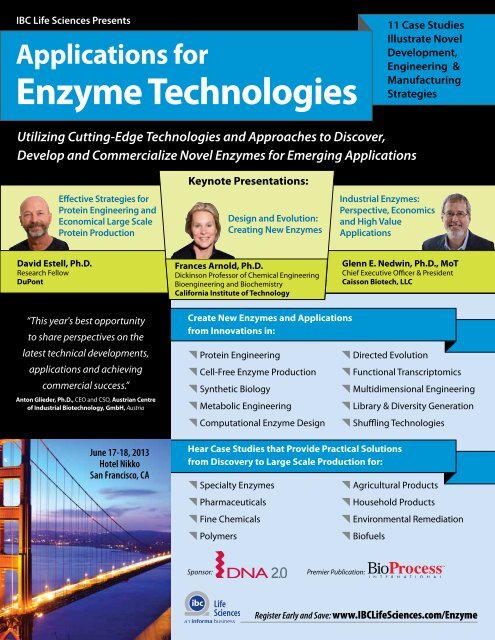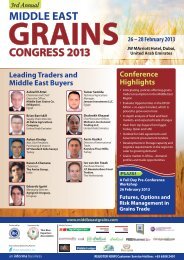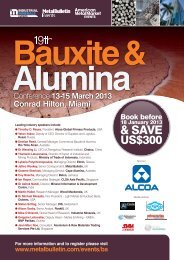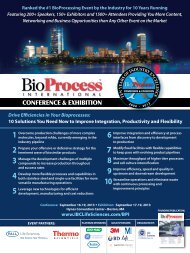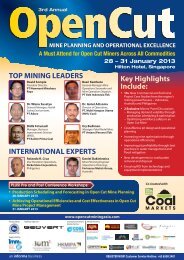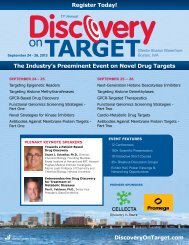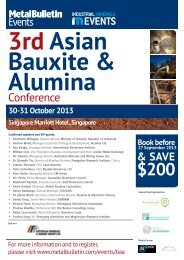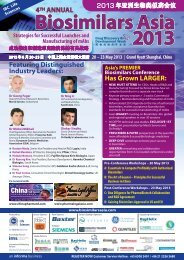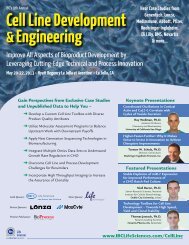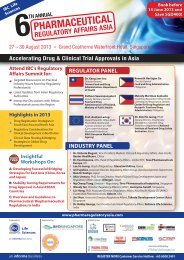Applications for Enzyme Technologies
Applications for Enzyme Technologies
Applications for Enzyme Technologies
Create successful ePaper yourself
Turn your PDF publications into a flip-book with our unique Google optimized e-Paper software.
IBC Life Sciences Presents<br />
<strong>Applications</strong> <strong>for</strong><br />
<strong>Enzyme</strong> <strong>Technologies</strong><br />
11 Case Studies<br />
Illustrate Novel<br />
Development,<br />
Engineering &<br />
Manufacturing<br />
Strategies<br />
Utilizing Cutting-Edge <strong>Technologies</strong> and Approaches to Discover,<br />
Develop and Commercialize Novel <strong>Enzyme</strong>s <strong>for</strong> Emerging <strong>Applications</strong><br />
Keynote Presentations:<br />
Effective Strategies <strong>for</strong><br />
Protein Engineering and<br />
Economical Large Scale<br />
Protein Production<br />
Design and Evolution:<br />
Creating New <strong>Enzyme</strong>s<br />
Industrial <strong>Enzyme</strong>s:<br />
Perspective, Economics<br />
and High Value<br />
<strong>Applications</strong><br />
David Estell, Ph.D.<br />
Research Fellow<br />
DuPont<br />
Frances Arnold, Ph.D.<br />
Dickinson Professor of Chemical Engineering<br />
Bioengineering and Biochemistry<br />
Cali<strong>for</strong>nia Institute of Technology<br />
Glenn E. Nedwin, Ph.D., MoT<br />
Chief Executive Officer & President<br />
Caisson Biotech, LLC<br />
“This year's best opportunity<br />
to share perspectives on the<br />
latest technical developments,<br />
applications and achieving<br />
commercial success.”<br />
Anton Glieder, Ph.D., CEO and CSO, Austrian Centre<br />
of Industrial Biotechnology, GmbH, Austria<br />
June 17-18, 2013<br />
Hotel Nikko<br />
San Francisco, CA<br />
Create New <strong>Enzyme</strong>s and <strong>Applications</strong><br />
from Innovations in:<br />
{ Protein Engineering<br />
{ Cell-Free <strong>Enzyme</strong> Production<br />
{ Synthetic Biology<br />
{ Metabolic Engineering<br />
{ Computational <strong>Enzyme</strong> Design<br />
Hear Case Studies that Provide Practical Solutions<br />
from Discovery to Large Scale Production <strong>for</strong>:<br />
{ Specialty <strong>Enzyme</strong>s<br />
{ Pharmaceuticals<br />
{ Fine Chemicals<br />
{ Polymers<br />
{ Directed Evolution<br />
{ Functional Transcriptomics<br />
{ Multidimensional Engineering<br />
{ Library & Diversity Generation<br />
{ Shuffling <strong>Technologies</strong><br />
{ Agricultural Products<br />
{ Household Products<br />
{ Environmental Remediation<br />
{ Biofuels<br />
Sponsor:<br />
Premier Publication:<br />
Register Early and Save: www.IBCLifeSciences.com/<strong>Enzyme</strong>
IBC Life Sciences Presents<br />
IBC’s Inaugural<br />
<strong>Applications</strong> <strong>for</strong> <strong>Enzyme</strong> <strong>Technologies</strong><br />
<strong>Applications</strong> <strong>for</strong> <strong>Enzyme</strong> <strong>Technologies</strong><br />
Utilizing Cutting-Edge <strong>Technologies</strong> and Approaches to Discover,<br />
Develop and Commercialize Novel <strong>Enzyme</strong>s <strong>for</strong> Emerging <strong>Applications</strong><br />
June 17-18, 2013 • The Hotel Nikko San Francisco • San Francisco, CA<br />
June 17-18, 2013 • Hotel Nikko • San Francisco, CA<br />
Dear Colleague,<br />
Welcome Back to <strong>Enzyme</strong> <strong>Technologies</strong>!<br />
Rapidly advancing technologies and the use of custom-made biocatalysts are producing exciting<br />
opportunities <strong>for</strong> emerging enzyme applications across several industries. Our intensive research<br />
with industry leading companies and experts in the enzyme field indicates a strong need <strong>for</strong><br />
a focused conference on the development and commercialization of enzymes and enzymatic<br />
processes, which is why we are proud to reintroduce IBC’s <strong>Enzyme</strong> <strong>Technologies</strong> conference.<br />
A Decade of Progress<br />
IBC’s <strong>Enzyme</strong> <strong>Technologies</strong> conferences, held from 1997-2003, provided a unique <strong>for</strong>um and<br />
community <strong>for</strong> those active in the young and growing field of biocatalyst development. Our exciting<br />
new program <strong>for</strong> 2013 is an applications focused conference which highlights exciting new technical<br />
developments and successes in the now-burgeoning enzyme market.<br />
Expanding Industry <strong>Applications</strong><br />
Biocatalysis has expanded into all areas of chemical synthesis, from the traditional fine chemical<br />
applications in pharmaceutical synthesis and larger scale commodity chemical industry, to the<br />
global consumer products and energy industries. This conference covers the breadth of these<br />
applications as well as the depth of the underlying science, from the discovery or creative innovation<br />
of new catalytic activities, to the economics of efficient enzyme production. Join us to hear the most<br />
recent learnings from all stages of research, development and commercialization that provide unique<br />
advantages in this ever developing sector.<br />
Your Participation is Requested<br />
Your attendance and enthusiastic participation at this event ensures the level of in<strong>for</strong>mation exchange<br />
and collaboration needed to foster new ideas, practical strategies and solutions that you can take<br />
home right away and apply at your organization. We hope you agree that the program is top notch,<br />
and that the shared knowledge that comes from your involvement will help propel the field towards<br />
further commercial success.<br />
Sincerely,<br />
Jeffrey Moore, Ph.D. Lori Giver, Ph.D. Barry Walsh<br />
Merck & Co., Inc. Codexis Corp. IBC Life Sciences<br />
Take an Active Role in the Conference and Present a Poster<br />
Any registered conference attendee may register to present a<br />
poster. The deadline to submit an abstract online is June 3, 2013<br />
to have the abstract be included in the conference materials.<br />
Full payment of conference registration and poster fees must<br />
be received by this date <strong>for</strong> the abstract to be included in the<br />
conference materials and a poster board assignment to be made<br />
(see the registration page <strong>for</strong> details on the poster fee). Posters<br />
should be PORTRAIT orientation, with maximum dimensions<br />
of 36 inches wide (3 feet) x 48 inches high (4 feet). Please note:<br />
Poster presentations may not be used as exhibit displays or <strong>for</strong><br />
marketing purposes, and all posters are subject to approval by<br />
conference organizers. Only one poster presentation is allowed<br />
per registered attendee/author.<br />
Drive Your Global Sales and Marketing<br />
IBC’s <strong>Applications</strong> <strong>for</strong> <strong>Enzyme</strong> <strong>Technologies</strong> event provides a<br />
number of sponsorship and exhibiting opportunities you can<br />
choose from to meet your goals be<strong>for</strong>e, during and after the<br />
event. IBC’s sponsorships ensure you the proper balance between<br />
attendees and exhibitors so you can spend more time developing<br />
your deals and less time searching <strong>for</strong> possible partners.<br />
Sponsorship/Exhibiting opportunities include Technology<br />
Workshops (including a thirty minute speaking slot); Session<br />
Sponsorships; Reception, Luncheon and Break Sponsorships;<br />
Delegate Focus Groups; Imprinted Giveaways; and much more.<br />
To learn more about sponsoring or exhibiting, please<br />
contact: Jennifer Thebodo at 508-614-1672 or<br />
jthebodo@ibcusa.com<br />
Register Early <strong>for</strong> Best Savings ■ www.IBCLifeSciences.com/<strong>Enzyme</strong> ■ 800-390-4078
Monday, June 17, 2013<br />
8:00 Chairwoman’s Opening Remarks<br />
Lori Giver, Ph.D., Vice President, Technology and Innovation, Codexis Corp.<br />
Keynote Presentations<br />
8:15 CASE STUDY Effective Strategies <strong>for</strong> Protein<br />
Engineering and Economical Large Scale<br />
Protein Production<br />
Protein engineering and directed evolution have proven<br />
effective techniques to produce enzymes with improved<br />
properties. In order to fully utilize these products, they must be produced in<br />
volumes (metric ton quantities), and at price points that are radically different<br />
from current pharmaceutical protein production volumes and economics.<br />
This requires a radically different approach to protein production.<br />
David Estell, Ph.D., Research Fellow, DuPont<br />
9:00 UNPUBLISHED DATA Design and Evolution:<br />
Creating New <strong>Enzyme</strong>s<br />
Biology offers elegant solutions to problems that range from<br />
producing fuels and chemicals from sunlight and carbon<br />
dioxide to combatting disease. Although biology has a large<br />
repertoire of catalytic functions, it does not include many that chemists<br />
have invented and developed in other contexts. This presentation describes<br />
new ef<strong>for</strong>ts to expand the repertoire of genetically encoded catalysts.<br />
Frances Arnold, Ph.D., Dickinson Professor of Chemical Engineering,<br />
Bioengineering and Biochemistry, Cali<strong>for</strong>nia Institute of Technology<br />
9:45 Networking Refreshment Break and Poster/Exhibit Viewing<br />
<strong>Applications</strong> from Discovery<br />
10:15 CASE STUDY • UNPUBLISHED DATA The Three Pillars of Evolutionary<br />
<strong>Enzyme</strong> Optimization<br />
The process of directed evolution can be viewed as a canonical optimization<br />
task comprised of three fundamental components: 1) Fitness function, 2)<br />
Diversity generation, and 3) Search algorithm. The presentation focuses on<br />
recent developments in the context of these components, discuss the critical<br />
interplay between them, and provide relevant examples that demonstrate<br />
the principles behind rapid and efficient enzyme optimization.<br />
Richard Fox, Ph.D., Research Fellow, Pioneer Hi-Bred International<br />
10:45 CASE STUDY Infolog-Based Protein Engineering Allows <strong>for</strong><br />
Controlled Navigation in Megadimensional Sequence Space<br />
Independently designed synthetic genes where substitutions are<br />
systematically incorporated (Infologs) allows <strong>for</strong> uni<strong>for</strong>m and maximally<br />
in<strong>for</strong>mation rich sampling of megadimensional sequence space. Infologs<br />
have been successfully used to engineer genes, proteins and pathways <strong>for</strong><br />
altered functionality. Several case studies are presented.<br />
Claes Gustafsson, Ph.D., Founder, Chief Commercial Officer, DNA2.0 Inc.<br />
11:15 UNPUBLISHED DATA Exploiting Squalene Hopene Cyclases and<br />
Their Catalytic Brønsted Acid <strong>for</strong> Non-Natural Reactions<br />
Squalene hopene cyclases (SHC) catalyze the Brønsted acid initiated<br />
cyclization of squalene to hopene via cationic intermediates in one of the<br />
most complex reactions known in biochemistry. By harnessing the catalytic<br />
machinery of SHCs we postulate that the pool of biocatalytic reactions <strong>for</strong><br />
these enzymes can be greatly expanded, bearing in mind the large diversity<br />
of reactions catalyzed by Brønsted acid catalysts in synthetic organic<br />
chemistry. To test this hypothesis molecules were designed which address<br />
not only substrate promiscuity (non-natural substrates) but also catalytic<br />
promiscuity (non-natural reactions). Employing this approach we show that<br />
SHCs can catalyze Friedel-Crafts alkylations and the synthesis of different<br />
heterocyclic compounds. Our results indicate that the catalytic machinery<br />
of SHCs can be exploited <strong>for</strong> general Brønsted acid catalysis in the chiral<br />
environment of the active site.<br />
Bernhard Hauer, Ph.D., Professor, Institute Of Technical Biochemistry,<br />
University of Stuttgart, Germany<br />
11:45 Technology Workshop<br />
This technology highlight session is available. For more in<strong>for</strong>mation contact<br />
Jennifer Thebodo at 508-614-1672 or jthebodo@ibcusa.com<br />
12:15 Luncheon and Poster/Exhibit Viewing<br />
1:25 Chairman’s Remarks<br />
Anton Glieder, Ph.D., CEO and CSO, Austrian Centre of Industrial<br />
Biotechnology GmbH, Austria<br />
<strong>Applications</strong> from Discovery (continued)<br />
1:30 Novel <strong>Enzyme</strong>s and Synthetic Pathways <strong>for</strong><br />
Bio-Based Chemicals<br />
The ability to rapidly and reliably design new enzymes is key to engineering<br />
customized cell factories <strong>for</strong> the production of novel fuels and chemicals. This<br />
presentation illustrates how Arzeda’s computational design technology <strong>for</strong> new<br />
enzyme activities is opening up avenues <strong>for</strong> the synthesis of truly novel metabolic<br />
pathways by designing– enabling the full potential of synthetic biology.<br />
Daniela Grabs, Ph.D., Chief Technology Officer, Molecular Screening,<br />
Arzeda Corp.<br />
2:00 CASE STUDY • UNPUBLISHED DATA Industrial <strong>Enzyme</strong> Discovery by<br />
Functional Transcriptomics<br />
In addition to bacteria plants, animals and fungi provide a vast and often<br />
complementary diversity of enzymes. Transcriptome sequencing, analysis<br />
and expression in yeasts as well as direct functional screening of normalized<br />
cDNA expression libraries now provide a similar simple and quick access to<br />
new enzymes from eukaryotes as from the bacterial world.<br />
Anton Glieder, Ph.D., Chief Executive Officer & Chief Scientific Officer,<br />
Austrian Centre of Industrial Biotechnology GmbH, Austria<br />
2:30 Developing <strong>Enzyme</strong>s <strong>for</strong> Environmental <strong>Applications</strong> –<br />
From Fund Research to Product Development<br />
Anthropogenic pollutants are a major concern in both developed and<br />
developing countries because of their potential adverse effects on human<br />
health and the environment. We have identified a number of enzymes <strong>for</strong><br />
exploitation as cell-free bioremediants of pesticides and herbicides. We<br />
have improved these enzymes in the laboratory to meet their commercial<br />
requirements (production qualities, kinetic properties, etc.).<br />
Colin Scott, Ph.D., Stream Leader, Division of Ecosystem Sciences,<br />
CSIRO Australia<br />
3:00 Networking Refreshment Break and Poster/Exhibit Viewing<br />
<strong>Applications</strong> of <strong>Enzyme</strong> Engineering<br />
3:30 The (Near) Future of Biocatalysis <strong>Enzyme</strong> Screening:<br />
sA Coming Together Of Genomics/ Metagenomics,<br />
Advanced High-Throughput Screening Technology and<br />
Rapid Structure-Assisted Biocatalyst Optimization<br />
The debate: should you scale your trans<strong>for</strong>mation now, keep on screening<br />
enzymes, or evolve current hit(s)? It’s situational of course - a complex<br />
interplay of fundamental and commercial factors. The current / future impact<br />
of expanding sequence databases, HT cloning, advanced cost-effective<br />
screening technologies, and optimization of biocatalyst per<strong>for</strong>mance by in<br />
silico sequence / 3D-structure in<strong>for</strong>med methods are discussed.<br />
Simon J. Charnock, Ph.D., Managing Director, Technical Director,<br />
Prozomix Limited, United Kingdom<br />
4:00 CASE STUDY • UNPUBLISHED DATA <strong>Enzyme</strong> Evolution - Theory and Practice<br />
This presentation describes experimental work aimed at understanding<br />
how enzymes evolve. Properties that drive enzyme evolvability are described,<br />
including functional promiscuity, structural plasticity, and the role of<br />
neutral mutations in promoting new functions. This presentation shows<br />
how these fundamental principles apply to specific cases, and how far<br />
enzyme engineering can get in terms of both rates and specificity.<br />
Dan Tawfik, Ph.D., Professor, Department of Biological Chemistry,<br />
Weizmann Institute of Science, Israel<br />
4:30 CASE STUDY • UNPUBLISHED DATA New Tricks with Old Yellow:<br />
Multidimensional Engineering of Enoate Reductases<br />
We have been exploring a combination of protein and cofactor engineering to<br />
identify novel enoate reductase variants with enhanced catalytic activity, as well as<br />
altered substrate specificity and enantioselectivity. These studies have been greatly<br />
facilitated through the use of fully synthetic gene libraries in combination with<br />
cell-free enzyme production, enabling rapid and comprehensive library analysis.<br />
Stefan Lutz, Ph.D., Associate Professor, Department of Chemistry,<br />
Emory University<br />
Register Early <strong>for</strong> Best Savings ■ www.IBCLifeSciences.com/<strong>Enzyme</strong> ■ 800-390-4078
Interactive Panel Discussion<br />
5:00 Transitioning from Academia to Industry - Improving the Academic-Industry Interface<br />
Moderator:<br />
Anton Glieder, Ph.D., Chief Executive Officer & Chief Scientific Officer, Austrian Centre of Industrial Biotechnology GmbH, Austria<br />
Panelists:<br />
Yasuhisa Asano, Ph.D., Professor, Biotechnology Research Center,<br />
Toyama Prefectural University, Japan<br />
Claes Gustafsson, Ph.D., Founder, Chief Commercial Officer, DNA2.0 Inc.<br />
Bernhard Hauer, Ph.D., Professor, Institute Of Technical Biochemistry,<br />
University of Stuttgart, Germany<br />
6:00 Cocktail Reception in Poster/Exhibit Hall<br />
Ephraim Honig, Ph.D., MBA, Chief Operating Officer, Strem Inc.<br />
Georg Schirrmacher, Ph.D., Clariant International Ltd. (invited)<br />
Andrew H.-J. Wang, Ph D, President, Federation of Asian and Oceanian<br />
Biochemists and Molecular Biologists (FAOBMB), Distinguished Research<br />
Fellow, Institute of Biological Chemistry, Academia Sinica, Taiwan<br />
Tuesday, June 18, 2013<br />
8:00 Chairman’s Opening Remarks<br />
Claes Gustafsson, Ph.D., Founder, Chief Commercial Officer, DNA2.0 Inc.<br />
Keynote Presentation<br />
8:15 Industrial <strong>Enzyme</strong>s: Perspective, Economics<br />
and High Value <strong>Applications</strong><br />
The talk explores a 20 year perspective on industrial enzymes.<br />
Specific examples are given on important production systems,<br />
a discussion on economics and some focus on high value<br />
applications, including, how chemo-enzymatic polymer production creates<br />
novel utilities <strong>for</strong> GAG synthase enzymes.<br />
Glenn E. Nedwin, Ph.D. MoT, Chief Executive Officer & President,<br />
Caisson Biotech, LLC<br />
<strong>Applications</strong> of <strong>Enzyme</strong> Engineering (continued)<br />
9:00 CASE STUDY Using Shuffling <strong>Technologies</strong> to Develop Specific<br />
Catalysts <strong>for</strong> Pharmaceutical Intermediates<br />
Codexis uses a suite of proprietary technologies to develop novel<br />
biocatalysts that can lead to commercial scale solutions <strong>for</strong> manufacturing<br />
and production. This presentation draws on several recent examples to<br />
illustrate the evolution process and how we work with our partners to<br />
enable new manufacturing routes to pharmaceutical intermediates.<br />
Lori Giver, Ph.D., Vice President, Technology and Innovation, Codexis Corp.<br />
9:30 UNPUBLISHED DATA Feedstock Engineering with Conditionally<br />
Activated <strong>Enzyme</strong>s<br />
In certain enzyme-dependent processes, premature activation of enzymes can<br />
detract from overall process per<strong>for</strong>mance. Agrivida has pioneered the use<br />
of inteins to engineer enzymes that are activated only under predetermined<br />
conditions that correspond to critical steps in a process or product<br />
application. We have used such intein-modified enzymes to enhance biomass<br />
hydrolysis and other applications involving industrial hydrolases.<br />
Philip A. Lessard, Ph.D., Project Manager and Head of Biochemistry,<br />
Agrivida, Inc.<br />
10:00 Networking Refreshment Break and Poster/Exhibit Viewing<br />
Specialty & Fine Chemical <strong>Enzyme</strong> <strong>Applications</strong><br />
10:30 CASE STUDY • UNPUBLISHED DATA <strong>Enzyme</strong> Process Scale-Up Using<br />
SelectAZyme<br />
The application of biocatalysis in chemical development continues to grow<br />
as it moves from the domain of specialised technology to mainstream<br />
methodology, a move that has been facilitated by the increasing commercial<br />
“off-the-shelf” availability of enzymes at large scale. This presentation,<br />
through actual case studies, illustrates the development and application of<br />
selectAZyme TM biocatalysts. Highlights of recent examples of the scale-up<br />
of biooxidation processed and application of ultrasound <strong>for</strong> the rapid<br />
synthesis of chiral intermediates is discussed.<br />
Tom Moody, Ph.D., Head of Biocatalysis & Isotope Chemistry,<br />
Almac Group, United Kingdom<br />
11:00 Recent Innovations in Biocatalytic Oxidation at Merck<br />
Abstract not available at press time. For up-to-date program in<strong>for</strong>mation,<br />
please visit www.IBCLifeSciences.com/<strong>Enzyme</strong>.<br />
Jeffrey Moore, Ph.D., Senior Investigator, Applied Biocatalysis,<br />
Merck & Co., Inc.<br />
11:30 UNPUBLISHED DATA Directed Evolution of <strong>Enzyme</strong>s to Provide<br />
New Biocatalysts <strong>for</strong> Organic Synthesis<br />
This presentation describes recent work from our laboratory aimed at<br />
developing new biocatalysts <strong>for</strong> enantioselective organic synthesis. For<br />
example, monoamine oxidases (MAO-N) are enzymes that catalyze the<br />
oxidation of amines to imines. MAO-N can be used as a biocatalyst to obtain<br />
enantiomerically pure chiral amines by deracemisation or desymmetrisation<br />
of substrates. Combination of MAO-N with imine reductases and<br />
transaminases enables new pathways to be developed <strong>for</strong> alkaloid synthesis.<br />
Nicholas J. Turner, Ph.D., Professor of Chemical Biology,<br />
University of Manchester, United Kingdom<br />
12:00 Pharmaceutical <strong>Applications</strong> of Biocatalysis<br />
Biocatalysis has been implemented in manufacturing processes <strong>for</strong> Pfizer<br />
products including Lipitor TM , Lyrica TM , and Xalkori TM . The development<br />
of enzymatic processes <strong>for</strong> these products, and other compounds,<br />
illustrates the use of several classes of enzymes including ketoreductases,<br />
transaminases, and ene reductases.<br />
John Wong, Ph.D., Research Fellow, Chemical Research and Development,<br />
Pfizer Inc.<br />
12:30 Luncheon and Poster/Exhibit Viewing<br />
1:25 Chairman’s Remarks<br />
Tom Moody, Ph.D., Head of Biocatalysis & Isotope Chemistry,<br />
Almac Group, United Kingdom<br />
Commodity <strong>Enzyme</strong> <strong>Applications</strong><br />
1:30 Novel <strong>Enzyme</strong> <strong>Applications</strong> in Pulp and Paper Treatment<br />
Paper products are essential components of modern life, important <strong>for</strong><br />
communication, packaging and a multitude of other uses. One advantage<br />
<strong>for</strong> the paper industry is that its basic raw material (fiber from trees) is<br />
renewable. <strong>Enzyme</strong>s are available that can modify these raw materials,<br />
improving the quality and production of paper products. Some replace<br />
conventional chemicals and others provide unusual novel benefits.<br />
Philip M. Hoekstra, M.S., Director, Systems & Support/Research &<br />
Development, Buckman International<br />
2:00 Directing Natural <strong>Enzyme</strong>s to Synthetic Polymeric Substrates<br />
The surface specific mode of action of enzymes combined with<br />
mild reaction conditions represent major advantages of enzymatic<br />
functionalization of polymeric materials when compared to chemical<br />
processes. Engineering enzyme surface properties, attachment of binding<br />
modules and addition of hydrophobins are useful strategies - apart from<br />
engineering the active site architecture – to improve the activity of enzymes<br />
on their non-natural polymeric substrates.<br />
Georg M. Gübitz, Ph.D., Professor & Head of Institute of Environmental<br />
Biotechnology, University of Natural Resources and Life Sciences, Austria<br />
2:30 Networking Refreshment Break and Poster/Exhibit Viewing<br />
Register Early <strong>for</strong> Best Savings ■ www.IBCLifeSciences.com/<strong>Enzyme</strong> ■ 800-390-4078
IBC Life Sciences Presents<br />
<strong>Applications</strong> <strong>for</strong><br />
<strong>Enzyme</strong> <strong>Technologies</strong><br />
June 17-18, 2013 • Hotel Nikko • San Francisco, CA<br />
Keynote Presentations:<br />
Design and Evolution:<br />
Creating New <strong>Enzyme</strong>s<br />
Frances Arnold, Ph.D.<br />
Dickinson Professor of Chemical Engineering<br />
Bioengineering and Biochemistry<br />
Cali<strong>for</strong>nia Institute of Technology<br />
Effective Strategies <strong>for</strong> Protein<br />
Engineering and Economical<br />
Large Scale Protein Production<br />
David Estell, Ph.D.<br />
Research Fellow<br />
DuPont<br />
Industrial <strong>Enzyme</strong>s:<br />
Perspective, Economics and<br />
High Value <strong>Applications</strong><br />
Glenn E. Nedwin, Ph.D. MoT<br />
Chief Executive Officer & President<br />
Caisson Biotech, LLC<br />
IBC Life Sciences Presents<br />
<strong>Applications</strong> <strong>for</strong><br />
<strong>Enzyme</strong> <strong>Technologies</strong><br />
11 Case Studies<br />
Illustrate Novel<br />
Development,<br />
Engineering &<br />
Manufacturing<br />
Strategies<br />
Utilizing Cutting-Edge <strong>Technologies</strong> and Approaches to Discover,<br />
Develop and Commercialize Novel <strong>Enzyme</strong>s <strong>for</strong> Emerging <strong>Applications</strong><br />
June 17-18, 2013 • Hotel Nikko • San Francisco, CA<br />
Learn from All Stages of Discovery, Research, Development and Commercialization, Including:<br />
{ Accelerating <strong>Enzyme</strong> Discovery Using Transcriptome Library<br />
Sequencing and Screening<br />
{ Creating New <strong>Enzyme</strong> Products From Protein Engineering<br />
and Directed Evolution<br />
{ Combining New Biocatalysts to Synthesize Natural Products<br />
and Pharmaceutical Intermediates in Novel Ways<br />
www.IBCLifeSciences.com/<strong>Enzyme</strong><br />
{ Increasing Role of <strong>Enzyme</strong>s In Household Products and<br />
New Product Segments<br />
{ Scaling-Up <strong>for</strong> Transfer of Bioprocesses from<br />
Fermenters to Batch Reactors<br />
{ Enabling Commercial <strong>Enzyme</strong> <strong>Applications</strong> through<br />
High Yielding Production Systems


